Have you ever stared at your aquarium and noticed that some of the plants aren’t looking their best? those are signs of too much light on aquarium plants – something all aquarists should know about.
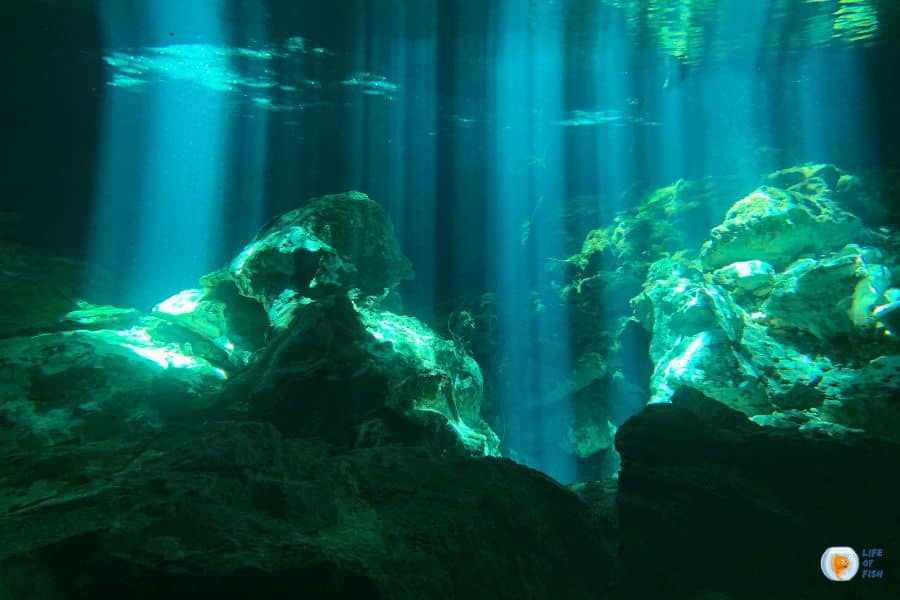
Excess lighting can lead to serious consequences for the health of your aquatic ecosystem. Therefore it’s important to understand what signs indicate that there may be too many lights in your tank. In this article, we’ll cover how to identify when your aquarium is getting too much light and how to solve the problem.
Aquariums provide a unique opportunity for us to observe and interact with our environment from an entirely new perspective. As such, it’s important that we are able to recognize any problems before they become a mess. One common issue among fish keepers is having an overly lit tank, which can cause significant harm if forgotten. Fortunately, there are several tell-tale signs you can look out for. Those will help alert you when things have gone awry.
Lighting plays an incredibly important role in keeping healthy growth within our fish tank. However, too much light can do more harm than good. The key lies in keeping a delicate balance between just enough and too much light. Something every fish keeper must strive towards! By understanding the warning signals associated with lot of lighting, you’ll be able to make sure your tanks stay as safe.
Signs of too much light on aquarium plants
Jump To
- 1 Signs of too much light on aquarium plants
- 2 What Are The Effects Of Too Much Light On Aquarium Plant
- 3 How To Regulate Aquarium Light Intensity
- 4 Can Aquarium Plant Have Light 24/7?
- 5 What Is Considered Low Light For Aquarium Plant
- 6 What Is Considered Bright Light For Aquarium Plant
- 7 How Long Should Aquarium Lighting Be On?
- 8 What Are The Potential Dangers Of Too Much Light For Aquarium Plant?
- 9 How To Reduce Light Intensity In Aquarium
- 10 What Are The Signs Of Light Deficiency On Plants
- 11 What Are The Signs Of Adequate Light Supply On Aquarium Plant
- 12 What Are The Pros And Cons Of Blue Light For Aquarium Plant
- 13 What Are The Pros And Cons Of Red Lights For Aquarium Plant
- 14 Is It Safe To Leave Aquarium Lights On 24/7?
- 15 How To Choose The Best Light For Your Aquarium Plants
- 16 Conclusion
It is important to make sure that your aquarium plant is getting the right amount of light. Too much or too little light can cause damage and result in a decline in health for aquarium plants. Understanding how to tell if your aquarium plants are getting too much light is key to having healthy, aquatic life.
When it comes to lighting an aquarium, choosing the right type of lighting is essential. LED lights offer more control over the intensity and spectrum of light than traditional fluorescent bulbs. Both important factors when think whether your tank has enough (or even too much) light. Depending on the species of plant you have, their individual needs will vary. However, certain signs indicate when there may be an issue with lot of light.
Wilting leaves or discoloration is a cue that your aquarium plants are receiving too much intense led light source. Additionally, algae growth could also signify that there is too much light present. As you know excessively bright conditions promote rapid growth which would then create competition for resources among other organisms living within the tank environment. Taking measures like moving the Led Light further away or using shades can help reduce any potential issues caused by high levels of illumination.
By recognizing these warning signs early and making adjustments accordingly, you can ensure optimum growing conditions for all of your fishy friends!
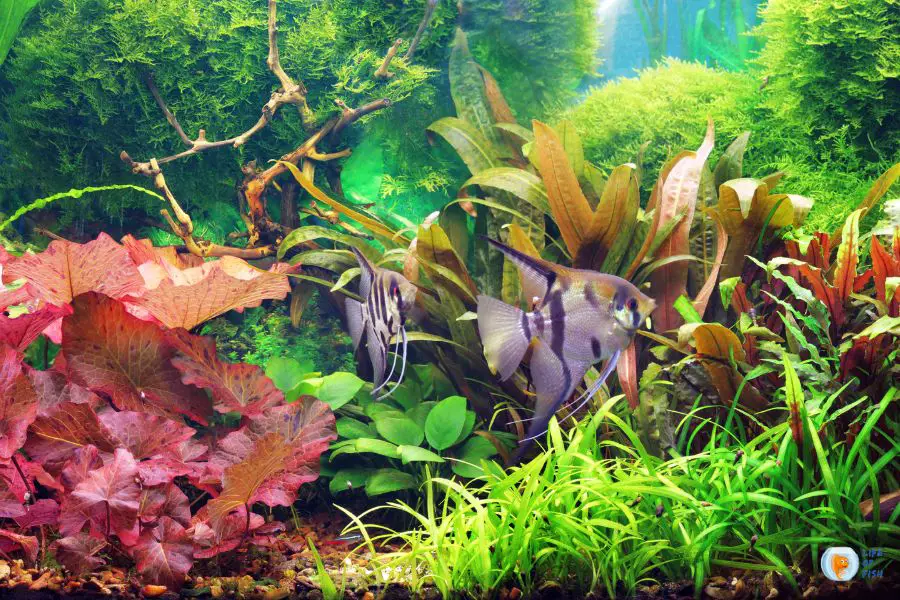
What Are The Effects Of Too Much Light On Aquarium Plant
When it comes to lights, understanding the effects of too much light on plants is important.
- Having an excessive amount of lighting can lead to a variety of issues. Such as discolored or yellowing leaves and stunted growth. It’s critical to know how much light your tank needs in order to keep your aquatic plants healthy.
- One sign that you may have too many LED lights over your tank is when your plant leaves start turning brown. This could be due to photosynthesis being inhibited by the high intensity of light, causing chlorophyll production to be reduced.
- Additionally, if you notice any algae starting to form around the edges of the tank. This could also indicate that there’s too much lighting from those LEDs.
It’s important not only to monitor the quantity but also the quality of the light for optimal results with your aquarium plant. To ensure their well-being, make sure you’re using appropriate wattage and that none of the equipment has been damaged during installation. Also check whether changes in temperature are creating more heat than necessary which can contribute to damaging foliage and encouraging disease development.
TIP: Monitor both the quantity and quality of your lights so they don’t negatively affect your plants’ health!
How To Regulate Aquarium Light Intensity
Regulating the intensity of light in your aquarium is essential for healthy plant growth. Aquarium plant need special care and attention, not only when it comes to the amount of water they receive but also how much lighting they require. LED lighting can help you manage the levels of illumination without compromising on quality or having to replace bulbs too often. Here are some tips for controlling the light intensity:
- Make sure you have an appropriate lamp fixture that will limit the wattage and allow for flexibility if needed.
- For example, a combination of T5 fluorescent lamps with adjustable power options could be used depending on the type of aquatic plants present in the aquarium.
- You should also consider investing in timers so that lights can be turned off at specific times during the day, allowing for a natural cycle just like what happens outside our homes.
- Monitor your tank’s environment regularly to ensure optimal conditions for plant growth.
- Check whether all types of plants are receiving enough light, as different species may require more intense illumination than others.
- If certain areas don’t seem to get enough light, adjust accordingly by adjusting both directions and distances between your lighting sources and aquariums walls/floor.
- Keep track of nutrient levels within your aquarium – excessive amounts can cause algae blooms which might block out important light from reaching your plants’ leaves, thus hindering their photosynthesis process!
By carefully monitoring and adjusting these parameters, you can create an ideal environment for growing beautiful aquatic plants in your home aquarium. With proper maintenance and regular check-ins on water chemistry, temperature and overall health of aquatic life; providing adequate lighting can become effortless and enjoyable task!

Can Aquarium Plant Have Light 24/7?
Many aquarium hobbyists wonder if they can leave the lights on their planted tanks 24/7. After all, plants need light to grow, and this could be a way to ensure they get enough of it. Unfortunately, too much light can do more harm than good – even when using blue or specialty grow lights.
Planted aquariums must have some periods of darkness in order for photosynthesis to occur correctly. When exposed to intense lighting nonstop, aquatic plants become stressed out and may start losing color or becoming damaged over time. To prevent this from happening, aquarists should make sure that their tanks experience at least 10-12 hours of uninterrupted dark each day; any longer and it’s possible that algae growth will take off as well!
It is important for those with planted tanks to find the right balance between adequate lighting for plant health and avoiding prolonged exposure which can cause damage. This might mean investing in specialized lighting equipment like blue lamps or LED bulbs designed specifically for aquatic environments. With careful monitoring of your tank’s environment, you’ll be able to create an ideal habitat where your plants thrive without being overexposed to harsh lighting conditions.
What Is Considered Low Light For Aquarium Plant
When it comes to aquarium plant, the question of how much light is too much can be a tricky one. All live plants need some light in order to grow and thrive, however too much light is not beneficial and can even cause damage. So what should you look out for when gauging low light levels?
A general rule of thumb is that if your tank has algae growth on the glass or decorations, then your lighting may be too bright. This could lead to burning of delicate leaves or stunted growth as well as an inability of the plant to absorb enough nutrients from their environment. Java ferns and java moss are particularly sensitive to high intensity lights so keeping them at lower levels is recommended.
In terms of wattage, most aquarium setups require between 0.5-2 watts per gallon depending on the types of plants being kept. For example, heavier rooted aquatic plants such as swords and crypts need more intense lighting than floating species like duckweed and water lettuce which do better with low wattage fixtures. Generally speaking, if your plant’s leaves start turning yellow or brown then they likely aren’t getting enough light and will benefit from additional illumination sources.
It’s important to remember that there isn’t a “one size fits all” solution when it comes to lighting requirements – every setup needs different amounts depending on factors such as type and number of plants, size/depth of the tank etc., so it’s worth doing research into specific requirements before making any changes to your current setup.
What Is Considered Bright Light For Aquarium Plant
When it comes to aquariums, the amount of light your plants receive is an important factor. Depending on what type of freshwater aquarium you have and what kind of plants you choose, bright lighting may be required for optimal growth. Planted tanks tend to require more intense lighting than those with just fish in them.
Fluorescent bulbs are a common option when choosing how much light to provide for planted tanks. These bulbs come in different wattages and Kelvin ratings; typically, brighter lights will produce greater plant growth. This means that for most requirements, a bulb rated at 6700K or higher should be chosen as this would be considered bright light. Additionally, providing carbon dioxide can also help with plant growth if additional nutrients aren’t available from other sources like substrate amendments or liquid fertilizers.
It’s worth noting that too much light can cause algae blooms and even injure some species of aquatic plants so finding the right balance between low and bright light is important for a thriving aquarium setup. Monitoring the health of your tank’s inhabitants regularly and adjusting accordingly is key to maintaining successful conditions in your aquarium environment.
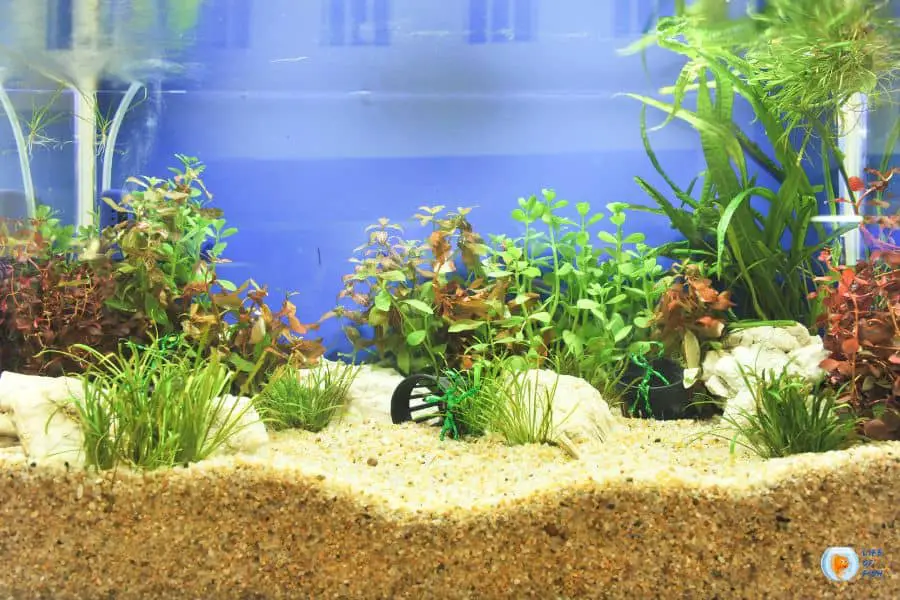
How Long Should Aquarium Lighting Be On?
When it comes to setting up a planted aquarium, one of the most important aspects is getting the lighting right. The amount and duration of aquarium lighting can have a huge impact on how well your plants grow, as well as preventing algae outbreaks. With this in mind, it’s essential to understand how long you should keep aquarium light on for optimal results.
In general, keeping lights switched on for 10-12 hours per day is usually enough for healthy plant growth. This range works best with full spectrum light fixtures since they provide a balanced combination of different types of light rays that are beneficial to aquatic plants. You may want to adjust the length slightly depending on the type of plants you have and their needs; some species will do better with more or less than 12 hours of light each day.
It’s also worth noting that too much light can cause an overgrowth of algae, which can quickly take over your tank if not managed properly. If you notice signs such as browning leaves, rapid algae growth or other issues associated with excess light exposure, You should reduce the number of hours your lights are on each day. And you should find the ideal balance between providing enough light while still maintaining good water quality and avoiding unsightly algae blooms.
What Are The Potential Dangers Of Too Much Light For Aquarium Plant?
Too much light for aquarium plant can cause serious problems. When we don’t follow the guidelines for our fish tank or water tank, it’s easy to give them more than they need and potentially harm their health. For example, if a betta fish is in an environment that has too much light, this can lead to turning brown which creates several issues. Let’s explore the potential dangers of providing too many lumens for aquatic life:
- Algae growth – An abundance of light will encourage fast-growing algae blooms, quickly making it difficult to keep the tank clean from excess plant matter.
- Stress – A drastic change in lighting conditions causes stress on aquarium inhabitants like betta fish as they have difficulty adjusting to such rapid shifts.
- Dehydration – Fish may become dehydrated due to extended exposure to harsh lighting leading to exhaustion and poor health over time.
- Death – Excessive heat caused by inadequate cooling systems combined with excessive amounts of light could be deadly for species prone to overheating.
In order to prevent these risks, it’s important that we understand how much light our tanks require based on the type of plants and creatures living inside. We should also pay close attention and make sure not to exceed those limits as doing so could put both plants and animals at risk.
How To Reduce Light Intensity In Aquarium
Having an aquarium with healthy plants is essential to the health of its inhabitants, but too much light can be detrimental. Knowing how to reduce light intensity in your aquarium will help keep your plants looking vibrant and lush. Here are three tips you should follow:
- Change the lighting schedule – Adjusting your lights from 12-14 hours per day instead of having them run continuously will help decrease the light intensity for your aquatic plants.
- Move the light away from the tank – Placing a distance between the source of light and the tank reduces direct exposure to intense light rays that could cause damage to delicate plant leaves.
- Add a shade cloth or filter – By using either one of these approaches over the top of your aquarium, it helps to lessen both indoor and outdoor sunlight as well as artificial lighting by up to 40%. This approach also prevents turning brown leaves caused by excessive heat.
It’s important to note that different types of aquatic plants require varying amounts of light; some need more while others need less. Knowing what type of plants you have in your tank allows you to adjust accordingly when reducing light intensity so they remain healthy and vibrant.
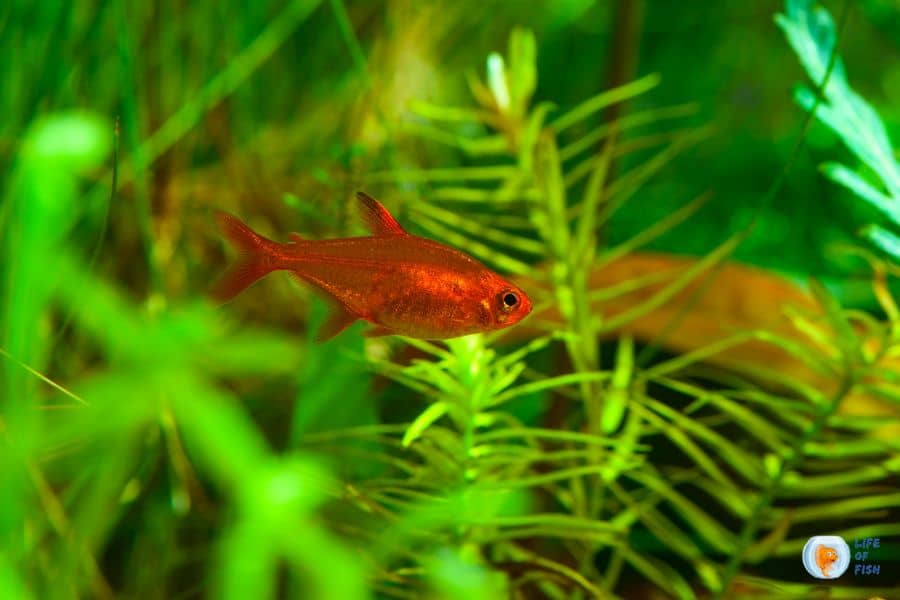
What Are The Signs Of Light Deficiency On Plants
Aquarium plantsneed the right amount of light to survive, but too much or not enough can both be harmful. Signs of light deficiency in aquariums can include stunted growth and brown spots on leaves. It’s important to recognize these signs so that you can make adjustments to your lighting accordingly.
One common sign of insufficient lighting is when the leaves start turning yellow or brown and begin to feel dry. Brown spots may also appear as a result of inadequate light levels; they usually look like small circles across the leaf surface. The roots might become weak due to lack of sufficient light and lead to reduced overall plant health.
It’s essential for aquarium owners to monitor their lights regularly. So they can solve any issues with intensity quickly. If there are signs of excessive or insufficient lighting, it could mean an adjustment should make by increasing or decreasing the time spent under grow lights each day. This will help ensure happy, healthy plants in your aquarium!
What Are The Signs Of Adequate Light Supply On Aquarium Plant
Adequate light supply is essential for plants to thrive. When you provide the right amount of light, not only will they develop better, but their colors and overall health will improve as well. There are a few signs that indicate an adequate level of light has been provided to them.
One sign that there’s enough light in the tank is if the leaves appear bright green or show off vibrant colors. If your plant looks healthy with deep hues and its shades remain consistent over time, it means that you’re supplying it with sufficient lighting. Furthermore, when exposed to adequate light intensity, aquatic plants may grow taller and wider than usual. you can see these changes within weeks or months depending on the species.
Lastly, having an appropriate balance between sunlight and shade inside your tank is another indication that you have met the ideal lighting requirements for your aquascape setup. Fish swimming around happily near the surface could also point towards a good distribution of lights in the aquarium environment. So make sure to check out all these factors before deciding whether your aquatic plants have gotten enough light!
What Are The Pros And Cons Of Blue Light For Aquarium Plant
The use of blue light for plants can be beneficial, but it’s important to understand the pros and cons before making a decision. Let’s take a look at what these are so you’re able to make an informed decision about your plants’ lighting needs.
One major pro is that blue light promotes photosynthesis in aquatic plants. This helps them grow faster than they would without the added illumination. It also allows for better nutrient absorption from their environment which leads to healthier leaves and stronger roots. Additionally, its wavelength penetrates deeper into the water column which encourages more growth of deep-rooted species.
On the other hand, there are some downsides associated with too much blue light exposure as well. Too much of this type of illumination can cause algae blooms that outcompete the aquarium plant for resources such as nutrients and CO2; this will eventually lead to stunted growth or even death in extreme cases. In addition, it may create unnatural colors on certain plant species due to the overstimulation of pigments, leading to less attractive results when viewed through an aquarium window.
When considering whether or not blue light is right for your aquarium setup, think carefully about how much you need and if any potential negatives outweigh the positives. You want to ensure your aquascape looks beautiful while still providing enough nourishment for your aquatic plants to thrive!
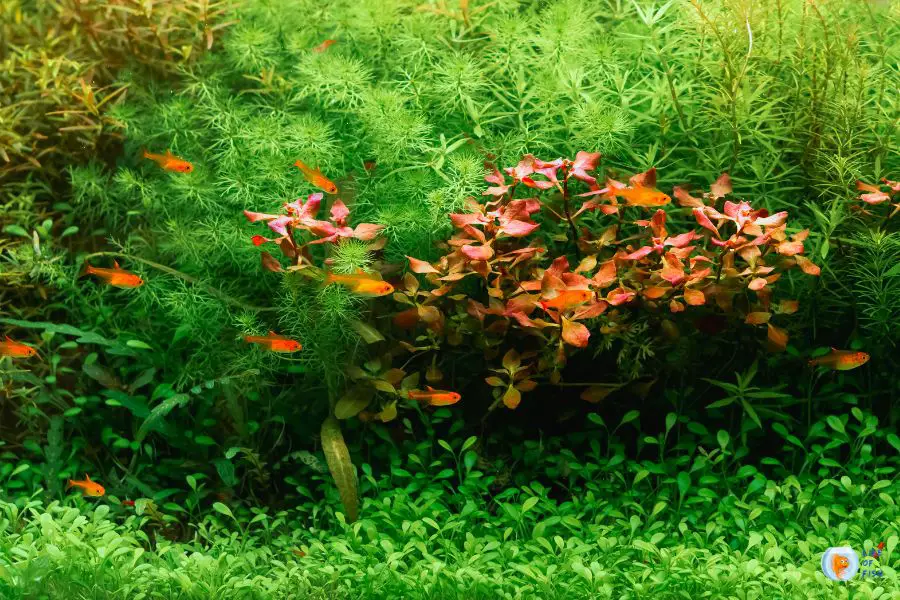
What Are The Pros And Cons Of Red Lights For Aquarium Plant
Using red lighting for plants can be beneficial, but it also has its drawbacks. To understand the pros and cons of this type of light, we’ll take a closer look at how it works.
Red lights are usually used to simulate natural sunlight in an aquarium setting. This helps to encourage healthy photosynthesis and boosts plant growth. Red lights also help increase coloration on certain types of aquatic plants like Anubias or Cryptocoryne species, making them more vibrant and attractive.
However, using too much red light can cause rapid algae growth due to the increased amount of photosynthetic activity that occurs with higher levels of red light exposure. Additionally, using only red light will limit the range of colors and shades seen in your tank’s inhabitants since other hues won’t be present without additional lighting sources such as blue or white LEDs.
When considering adding red lights to an aquarium setup, it is important to consider both the potential benefits and risks associated with their use. Doing so will ensure you create a beautiful space that meets your needs while avoiding any unwanted consequences from overexposure to bright red lights.
Is It Safe To Leave Aquarium Lights On 24/7?
It’s important to understand the impacts of light on aquarium plants. Too much light can lead to algae growth, nutrient deficiency and even plant death. So it’s natural for aquarists to wonder: is it safe to leave lights on 24/7?
The answer isn’t necessarily straightforward. On one hand, many plants naturally grow in areas with long days and short nights – so some species may benefit from longer exposure to light. However, constant lighting also increases photosynthetic activity which could result in an increase of dangerous compounds such as nitrates or carbon dioxide if not properly managed by adequate water changes and filtration systems. Additionally, certain forms of artificial lighting emit a lot of heat that can raise tank temperature beyond what most aquatic plants are used to.
So while leaving your aquarium light on all day might be beneficial for some types of plants, it’s best done after careful consideration taking into account the type of plants you have, their needs and how well your system filters out any buildup caused by prolonged periods of intense lighting. Ultimately, determining whether continuous illumination is right for your setup will depend heavily on these factors as well as other variables like room temperature and humidity levels.
How To Choose The Best Light For Your Aquarium Plants
Choosing the right light for your aquarium plant is essential for their health. But, how can you make sure it’s the best one? Here are some tips to help you out.
First, consider the amount of light needed by your particular species of plant. Too much or too little could be detrimental – so check with an expert if you’re unsure. Also think about the intensity and duration of this light; while some require more direct sunlight, others may need a few hours less each day. Plus, be mindful of different temperatures that might affect the growth rate of your plants.
It’s also important to choose a fixture that will provide even lighting throughout the tank, as well as being energy-efficient and easy on your wallet. Look into LED lights since they come in various colours and wattages and last longer than other fixtures. Furthermore, ensure whatever type of bulb you choose has adjustable settings so you can tailor its output depending on what’s necessary for your aquatic friends.
So when selecting a light source for your aquarium plants keep these points in mind: understand what kind of needs they have related to amount, intensity and duration; get a fixture that offers efficient coverage; opt for something durable like LEDs; and adjustability should always be high on the list!
Conclusion
It’s important to make sure your aquarium plant get the right amount of light every day. Too much or too little can have a negative effect on their growth and health. The type of lighting you use matters, too. You may want to consider blue lights for increased photosynthesis, while red lights are better suited for low-light species. Remember that it isn’t safe to leave light on 24/7; in most cases, 10–12 hours is enough.
When selecting the best light for your aquarium plants, take into account both the intensity and duration of exposure they need. Monitor them regularly so you can spot any signs of too much light as soon as possible. If I notice any changes like wilting leaves or discoloration, I’ll adjust my lighting accordingly. Lastly, ensure you provide adequate nutrients and good water quality to promote healthy plant growth. With the right balance of light, nutrition and care, your aquatic plants will thrive!
Read Next : How To Keep Floating Plants In One Place In The Aquarium
